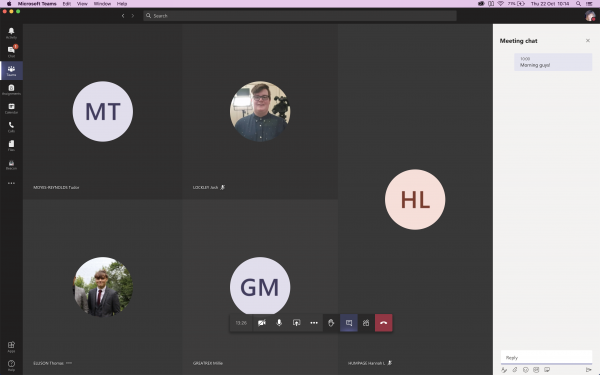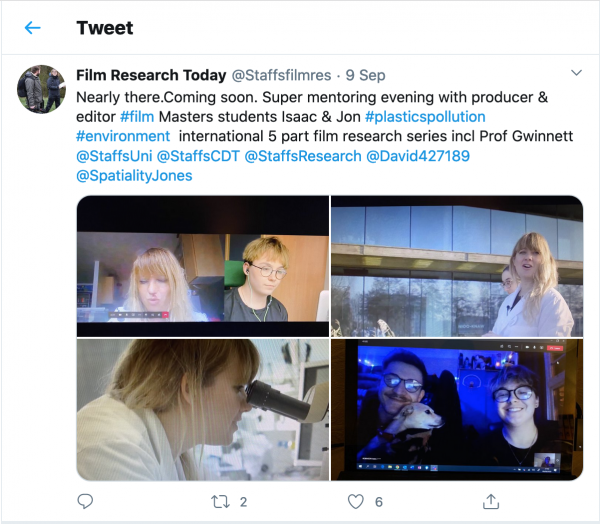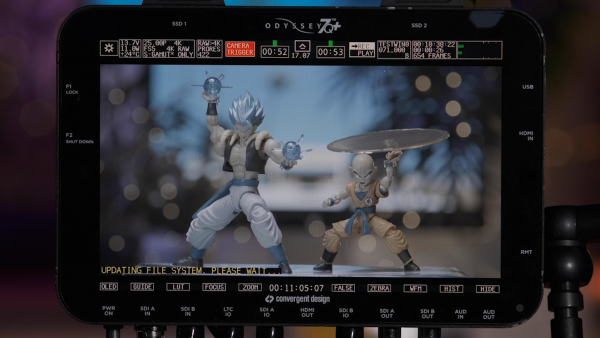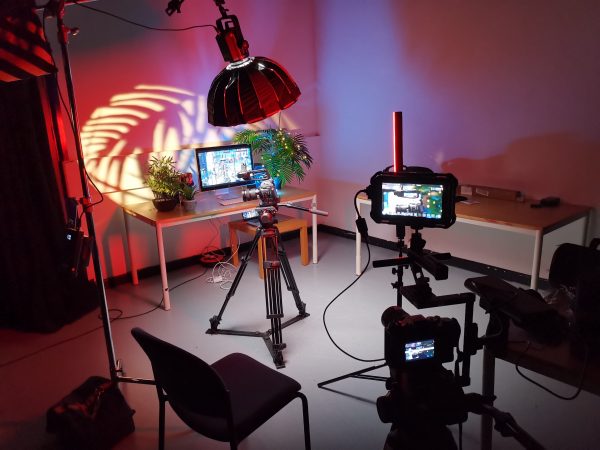“Can you hear me?” this question rings out on a very regular basis for anyone in a profession which has moved to online spaces. It’s certainly become, in recent months, a familiar refrain in educational delivery across the country as teachers, college, and university lecturers moved abruptly into the very different realm of fully online teaching and learning. It is a sentence which encompasses the mix of technological unfamiliarity, self-doubt, uncertainty and sudden self-awareness that marks an online conversation or delivery of information, an undiscovered country that we all thought we knew something about. We also felt well prepared for it, but found that we are not as well equipped as we first thought, and that all the time we lavished upon social media has not really readied any of us to spend even more time online in a much more formal way.
While many schools and colleges have moved back to face to face delivery, universities have had to tread a much rockier path to finding a new balance between in-person and digital delivery. Pressures upon Higher Education institutions during the months of Covid-19 related lockdowns and exam concerns have been numerous and well-documented, indeed in these first weeks of a new semester universities have been regularly in the news because of infection rates and difficulties in managing delivery of blended learning, including what it actually means and whether it offers what students joining HE thought they would be getting.

A breakout session in Teams for a crew. Working in an online space is new for everyone but offers new skills and understanding of the ability to work remotely but together. Still authors own.
This article however is not about the negatives but the positives, or at least the potential that this period of time gives those in HE to consider new approaches and how we might use technology to change the way some content is delivered. What opportunities does this enforced change and adaptation encourage and offer for those of us in Higher Education, and especially those of us who work in areas which are normally associated with hands on technical instruction and use of kit, hardware, and software on campus? Can we look at this change as a chance to become something more, something different but better? The answer is yes, but it will demand a great deal of adaptation both within academia and the student body to make it work as it has the potential to.
An area which might benefit from remaining in the digital world is the lecture. By delivering lectures online attending students can ask questions to clarify and contribute in ways they would perhaps not in the large lecture theatre, which for many is an intimidating space. There is the opportunity in the chat window to get direct answers from the lecturer where needed, there are tools available to encourage engagement and to gauge understanding and comprehension of specialist terms and work to be undertaken outside of class time. Such a change in delivery does offer some challenges which might be met by a change in style of presentation, having two lecturers in the session contributing different roles or the breaking up of the content to encompass small breakout activities normally reserved for seminar sessions. There is also, of course, the need for the delivery software to progress to allow real time screening of clips (audio and moving image) to allow examples to be offered within the lecture and to provide the basis of discussion in the session.
By offering the lecture portion of a module online it is possible to make better use of spaces through the day for delivering hands on sessions when we are able to once again do so (more) freely. The size of an online group can be much bigger than that of a traditional lecture space allowing certain relevant sessions to be shared beyond a specific cohort, potentially freeing lecturer time for alternate activities with students face to face. Using online space in this way means smaller packets of information can be delivered without the need for travel or the necessity to immediately undertake a related small group activity afterwards. This change means there is time to explore the information from a lecture, to complete specific activities related to it independently, or to hold a screening, recital, or virtual tour of a space which relates to the module or discipline. All of these activities would normally eat into a lecturer’s teaching allocation. However, using the virtual world they are accessible and could add greatly to the scope of a subject and specific sessions.

Film Masters students, Isaac Robinson and Jon Eley taking part in an online International 5 Part Research Series with Professor Claire Gwinnett from Staffordshire University – Sep 2020. Image from Twitter – Courtesy Film Research Today.
Before we continue it is incredibly important that online delivery is not seen as the low cost, low time answer to budget constraints as doing so will negate all of the positive potential this style of delivery offers. It is also vital that the hours and effort which successful online content requires are considered and acknowledged by those managing these activities and the staff responsible for them. Viewing this possible change as a means to limit staff or negate their experience and contribution will lead to poor quality courses and disappointed students. Such online content also requires students to adjust their relationship to the screen and to adapt to focussing upon a single task (not multi-screening whilst in a virtual learning space) and being present in the moment and the experience that is that class. The temptation is always there for students to turn their attention away from the delivery in a lecture and this is not manageable when students cannot be seen, therefore such classes would require a slightly different way of offering the content, using engagement tools and needing higher input from those attending than a normal in person lecture based session.
Another aspect that this delivery method raises is the provision of recording the lecture. Different institutions have different policies; however, it is important to question the importance of the recording when a live but online delivery is possible. To encourage the students to be present and engaged is paramount, a recorded access option suggests the content will be encountered later without the opportunity to check knowledge or understanding in the moment. The quantifying reason is so those attending can revisit the session, however this again disqualifies other skills which university encourages, one of which is independent learning, discerning what you as a student of the subject need to take from a session and developing those skills to filter and augment information as relevant for you.

Offering specific set-ups for equipment with detailed investigation of information screens ensure all students can see such details and then book equipment out to test their skills.
Courtesy - Ian Thurstan, Technical Specialist: Image taken from the Technical Instruction sessions created by the Media and Communications Technical Service Team at Staffordshire University
Something which has become clear even over these early weeks of delivery is the value and importance that students place on creating and using the equipment associated with their subject. With this in mind it is clear that face to face teaching must remain a bedrock of these courses, where using specialist equipment is a central element of the programme. Within the rules of social distancing and health and safety compliance equipment use under Covid-19 has been difficult, the tradition of student groups having kit in a class cannot be easily completed as such a session removes a large amount of kit from rotation for cleaning and quarantine. This is an element of face to face sessions that has no real equal, students need to use equipment, experiment with it and work with it to test their knowledge and how they might develop and apply their learning. However, we can take some of the adaptation we have made to currently limit in person delivery and working practice forwards in this area too, to the benefit of staff and students alike.

Working through recorded delivery allows detail to be easily pointed out for students and enables those students to easily revisit specific content before using TI question and answer sessions online.
Courtesy - Ian Thurstan, Technical Specialist: Image taken from the Technical Instruction sessions created by the Media and Communications Technical Service Team at Staffordshire University
Technical Instruction (TI) is a key aspect of students working with equipment, hardware and software. This very specialist knowledge must be delivered to the students in a clear and succinct way as not just working practices are a focus – health and safety is also central to this content. Traditionally this takes place as a hands-on session in a group, but recent changes have suggested there is a better way. By placing TI into ready packaged recorded sessions students have the opportunity to work at their own pace through the training, to revisit difficult or complex content and to practice alongside of a session, checking their understanding as they need to. However good a TI session is it constitutes a great deal of new information which can be overload for some students, conversely those students coming from tech heavy FE or school subjects can feel uncatered for and not pushed within the sessions, sometimes leading to absences. By having basic elements available as online recorded content, in person TI’s can be used to check student progress and understanding and to also deliver sessions with more specialist applications for the kit. This way students can be progressed further in face to face sessions whilst being supported as individual learners. Staff delivering these sessions also have the chance to explore other aspects of the kit rather than limiting themselves to repeated exploration of basic use.

A still from the set up for one of the many TI sessions which went into online delivery for 2020.
Courtesy - Ian Thurstan, Technical Specialist: Image taken from the Technical Instruction sessions created by the Media and Communications Technical Service Team at Staffordshire University
Adaptation is a key skill which those working in the creative industries and beyond need to nurture and grow. In the weeks leading to lockdown and the move to online delivery these skills were demonstrated by HE staff and their students in abundance across the country. From personal experience colleagues became solution orientated, sourcing tools and approaches from a range of locations to ensure that students were able to complete their studies. Students also responded with understanding of the situation and worked to find ways to complete their outputs, adapting and changing their approaches to fit the new and unexpected circumstances. The situation then and now has underscored the fact that we are a community, one which grows and changes and one, importantly, that influences each other.
With this in mind it is important to retain some of the working practices which were co-opted for teaching during lockdown and use them to ensure we have confident graduates capable of problem solving when they must work and communicate remotely. In Film and Media, we are lucky that we can let industry guide us in distance working methods and these changes are aspects which as a discipline we would do well to maintain and pass on. Using group meeting apps to ensure limited crew numbers on a shoot, using file sharing and remote transfer of content to allow students the scope to focus on their specialism and yet work apart, online collaboration tools to keep records and share content, and finding new ways to create when the old are not possible all need to be promoted within this subject.
Another area which such application of technology, and remote working, assists is that of sustainability, sustainable practice and product creation. Equipping students with the skill set to be aware of and involved in sustainable production processes is incredibly important. By embracing an attention upon sustainability and the ways in which working practices can contribute to lowering carbon footprints and the impact of production means that we are assisting students to be responsible creators. By encouraging student crews to use technology to enable participation we can also think about the opportunity for members of the team who are less mobile physically to be involved in activities which might under in person circumstances be difficult to access. Additionally, through the use and habituation of remote working techniques we can encourage our students to become “glocal”, assist them to remain local creatives who are able to work nationally and internationally without having to necessarily move to different part of the globe. Keeping talent in the area adds immeasurably to the life of a community and if we consider that many creatives are independent such flexibility of work life might enable graduates to establish themselves in areas where they can afford to make their art as well as work as a part of the industry.

Working collectively on industry style shoots is still a cornerstone to film and media delivery. A music video shoot from 2016 at Staffordshire University illustrates the importance of group work and being able to collaborate in person. Courtesy – Paul Ottey, Course Leader Film and Media Production, Staffordshire University.
Such inbuilt reliance on technical answers to creative problems does bring us to the issue of national connectivity and access to technology, the inadequacies of a nationwide infrastructure which assumes a connectivity and digital status not enjoyed by all has been spotlighted. In this respect it is clear how easy it is to overlook that some students do not have a home computer or laptop on which to complete specialist work when university premises are unavailable. Or who have the technology but lack reliable internet infrastructure to share their outputs. Such technological inequality is not easily addressed, indeed students coming to any university for a practical course do so in part because of the resources provided for them on that programme. The ability to use resources beyond their own budgets or knowledge is a key aspect of choosing to study these disciplines at HE. Should a university demand students outlay more money, on top of tuition and accommodation/course expenses, to buy laptops and lower end equipment?
Realistically not, pursuing such an American model of expectation of individual investment in technology is unfair to those students who want to study a subject but are financially limited. Something which has always been an important hope for British Higher Education is the ability of all to access it. With financial implications already large for today’s student cohort adding additional expenses is unfair and threatens to limit the already uneven playing field that is HE access. Therefore, universities must invest in having specialist laptops available for loan to those students who may require them should a campus move to online only delivery. Such a purchase also means that those having to be away from university for health or personal reasons could also be offered the option of being able to continue their studies should they wish to.
The final consideration is the wider university experience, the social and professional needs of those traditionally expecting to be on-campus for 3 to 4 years when delivery in that space becomes difficult or impossible to maintain through forces outside of University control? The creation of friendships and working relationships is a central one in the creative industries and is something which is encouraged as an integral part of such courses. The ability to work with others and to find those with skills that compliment is an important concern alongside the changing outlook and confidence levels that being at university offers. If we look at a singularly digitally based iteration of that experience then we can expect to lose the voices and engagement of some, for personal reasons but also for the earlier explored issues of connectivity and access. In person experience is therefore an element for a traditional cohort which must be maintained and encouraged in terms of friendship and professional connections, alongside simply the reality of being a part of campus life.
If we return to my opening question “Can you hear me”? It is clear that at the moment for some members of faculty and the student body the answer is “Not always”, but the important thing is we’re all trying.
About the Author
Dr. Sharon Coleclough completed her PhD in Cinematic Performance at the University of Salford in 2014. A Senior Lecturer in Film Production and Sound Design at Staffordshire University, her work combines the theory and practice of moving image production; focussing upon the ways in which meaning is created through the technical application of craft. Recent publications consider the relationship of BAME actors to lighting and camera for Viewfinder Magazine with an inspiring lecture series submission requested by Learning on Screen on the same subject. Sharon works internationally on a collaborative digital project, “The Laptop Tour” which considers the ways performance can be realised through the use of technology.
